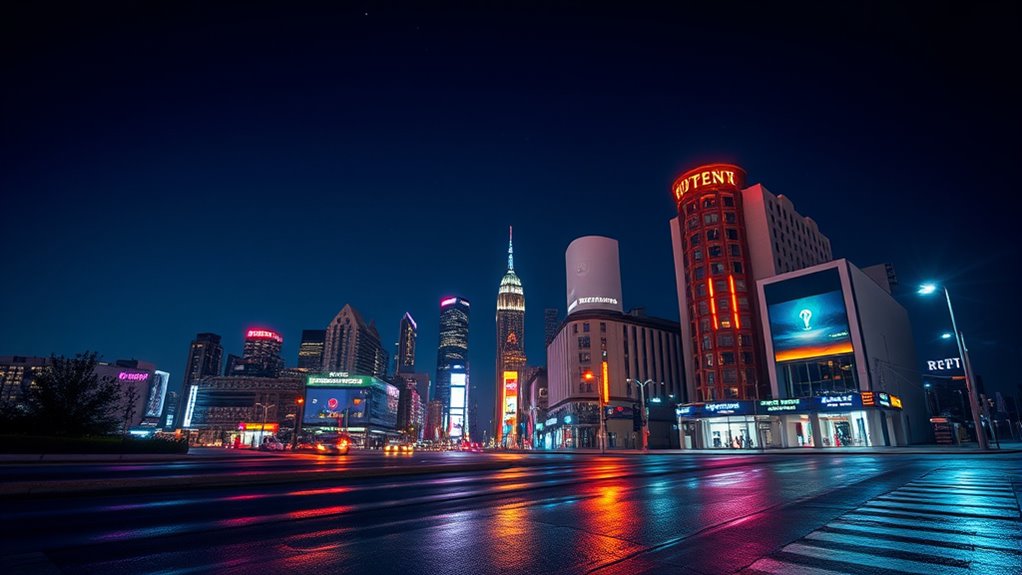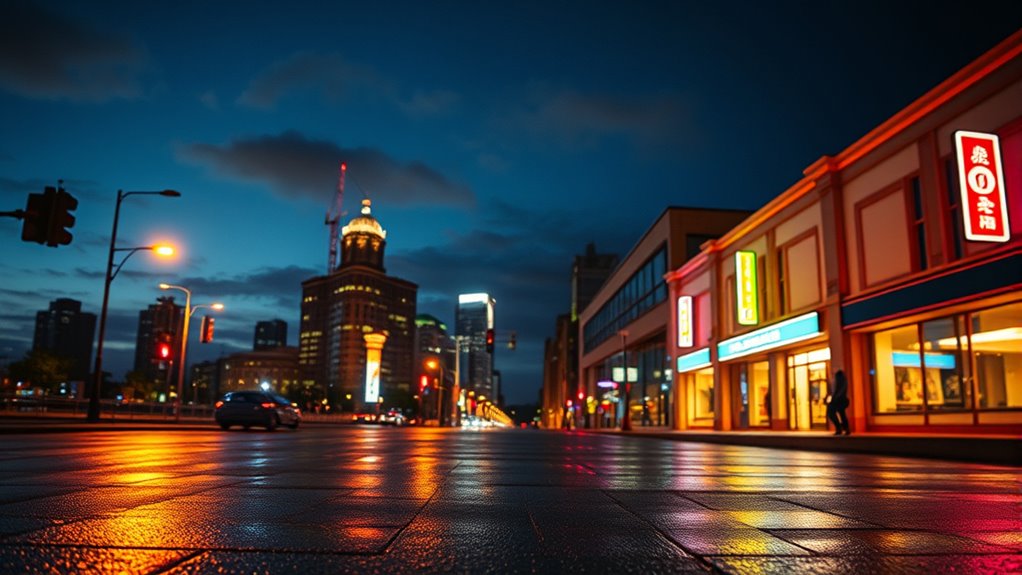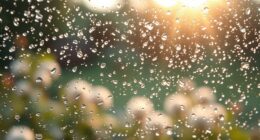To get accurate colors in night photography, you need to carefully set your white balance based on lighting conditions. Use manual or custom modes to adjust for different sources like streetlights, moonlight, or infrared atmospheres. Understanding how color temperature impacts your images helps you prevent unwanted color casts. Fine-tuning these settings guarantees your photos reflect true scene tones and moods. Keep exploring to discover more tips for mastering color calibration in challenging nighttime environments.
Key Takeaways
- Adjust white balance manually or with custom settings to correct color casts caused by low light or infrared conditions.
- Use Kelvin temperature control to fine-tune color accuracy based on different light sources at night.
- Understand infrared color shifts and apply appropriate white balance adjustments for true-to-life or artistic effects.
- Match white balance to scene lighting (e.g., city lights, moonlight) to preserve natural ambiance and mood.
- Regular calibration and careful white balance settings enhance color fidelity and overall image quality in night photography.

Night photography presents unique challenges, especially when it comes to capturing accurate colors. The low light conditions can throw off your camera’s automatic white balance, resulting in images that look unnatural or have an unwanted color cast. To achieve true-to-life colors, you need to understand how to adjust white balance settings and utilize techniques like infrared imaging and color temperature adjustment effectively. Infrared imaging, although often associated with specialized photography, can be used creatively to produce surreal images with distinctive color palettes. When capturing infrared images, your camera detects wavelengths beyond visible light, which can cause color shifts that differ from standard photography. Adjusting the white balance becomes vital here, as you need to set it appropriately for infrared to prevent your photos from looking overly green, magenta, or unbalanced. Manually setting the white balance or using a custom white balance mode helps guarantee that the infrared images reflect the desired mood and color accuracy. Additionally, understanding the impact of lighting conditions on white balance adjustments is essential for achieving accurate colors in night photography.
Even when working with visible light, color temperature adjustment plays a pivotal role in night photography. Different light sources emit varying color temperatures, affecting how colors appear in your photos. For example, sodium vapor lamps cast a warm orange glow, while LED or fluorescent lights can produce cooler tones. Without proper adjustment, your images may have an overall color cast that distracts from the scene’s natural beauty. To tackle this, you can manually dial in the right color temperature setting on your camera, matching it to the dominant light source or using a preset mode designed for specific lighting conditions. Many cameras also offer a Kelvin scale, allowing precise control over the white balance. This flexibility lets you fine-tune the colors, ensuring that the scene’s ambiance is accurately captured, whether you want to emphasize the warm glow of city lights or the cool tones of moonlit landscapes.
Frequently Asked Questions
How Does Ambient Lighting Affect White Balance Choices?
Ambient lighting, especially artificial lighting, greatly influences your white balance choices. It affects the overall color temperature of your scene, making colors appear warmer or cooler. When shooting at night, you need to modify your white balance to match the dominant artificial light source, whether it’s sodium vapor lamps or LED lights. Doing so ensures your photos have accurate colors and a natural look, regardless of the varying ambient light conditions.
Can Post-Processing Fully Correct Color Calibration Issues?
Post-processing can fix many color calibration issues, but it might not fully eliminate a strong color cast. You should use calibration tools like gray cards or color targets to set a solid baseline before shooting. While editing software can correct minor problems, relying solely on post-processing risks losing image quality and accuracy. Proper in-camera adjustments combined with calibration tools give you the best results for true color fidelity.
What Are the Best White Balance Settings for Different Night Scenes?
Think of your camera as a painter choosing the right colors. For night scenes, set your white balance to match the light source: use tungsten for warm, indoor-like glows or daylight for cooler, outdoor atmospheres. Adjust the color temperature to fine-tune your scene’s mood, ensuring the colors look natural. Experiment with these settings to match your scene’s lighting, creating a balanced and authentic night photograph.
How Do I Calibrate My Monitor for Accurate Night Photo Editing?
To calibrate your monitor for accurate night photo editing, start by using a hardware calibration tool like a colorimeter. Follow its instructions to run the calibration process, ensuring your monitor displays true colors. Adjust your monitor’s settings if needed, and save the calibration profile. Regularly calibrate to maintain color accuracy, which is essential for editing night photos accurately and ensuring your images look consistent across devices.
Does White Balance Impact Noise Levels in Night Photography?
White balance doesn’t directly affect noise levels in night photography, but it can influence how you perceive noise and image sharpness. If you set your white balance incorrectly, your photo might look dull or overly warm, making sensor noise more noticeable. Proper white balance helps you see the true image details, so you can better manage noise and retain sharpness. Keep your settings accurate, and your night shots will shine brighter.
Conclusion
Mastering white balance and color calibration transforms your night shots from mere darkness to stunning visuals. Think of it as revealing a secret key that reveals true colors hidden in the night. When you fine-tune these settings, you don’t just capture images—you craft a vivid story in every frame. So, don’t let the night’s mystery remain obscured—embrace these techniques and turn darkness into a canvas of mesmerizing colors.









